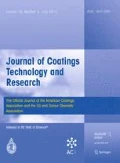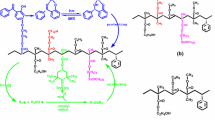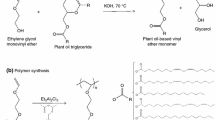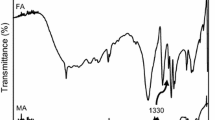Abstract
In the present study, vinyltrimethoxysilane was used to modify high-ortho novolac resin (NR) to obtain a vinyl silicone-modified phenolic oligomer (Si-mod NR). Subsequently, this oligomer is polymerized with methyl methacrylate. The mid-products (NR and Si-mod NR) and synthesized silicone-modified phenolic/acrylic resin (Ac/Si-mod NR) were characterized by Fourier transform infrared spectroscopy, and thermal properties were investigated by using thermal gravimetric analysis and differential scanning calorimetry techniques. In addition, the surface coating properties, including drying, hardness, adhesion, impact resistance, gloss, acid, alkaline, water, and solvent resistance of the films prepared from these products, were comparatively investigated. The results showed that the modification reactions yield a novel resin (Ac/Si-mod NR), which can be easily used as a surface coating material with high thermal resistance, flexibility, and excellent film properties.




Similar content being viewed by others
References
Platzer, N, “Phenolic Resins, Chemistry, Applications and Performance—Future Directions, by Andre Knop and Louis A. Pilato, Springer-Verlag, Berlin, 1985.” J. Polym. Sci. Part C Polym. Lett., 24 659–660 (1986)
Gardziella, A, Pilato, LA, Knop, A, Phenolic Resins: Chemistry, Applications, Standardization, Safety and Ecology, 1st edn. Springer, Berlin. https://doi.org/10.1007/978-3-662-04101-7 (2000)
Zhang, Y, Shen, S, Liu, Y, “The Effect of Titanium Incorporation on the Thermal Stability of Phenol-Formaldehyde Resin and Its Carbonization Microstructure.” Polym. Degrad. Stab., 98 514–518 (2013)
Martín, C, Ronda, JC, Cádiz, V, “Boron-Containing Novolac Resins as Flame Retardant Materials.” Polym. Degrad. Stab., 91 747–754 (2006)
Wang, S, Jing, X, Wang, Y, et al. “High Char Yield of Aryl Boron-Containing Phenolic Resins: The Effect of Phenylboronic Acid on the Thermal Stability and Carbonization of Phenolic Resins.” Polym. Degrad. Stab., 99 1–11 (2014)
Yun, J, Chen, L, Zhang, X, et al. “Synthesis and Structure Evolution of Phenolic Resin/Silicone Hybrid Composites with Improved Thermal Stability.” J. Mater. Sci., 53 14185–14203 (2018)
Xu, P, Jing, X, “Pyrolysis of Hyperbranched Polyborate Modified Phenolic Resin.” Polym. Eng. Sci., 50 1382–1388 (2010)
Guo, Z, Li, H, Liu, Z, et al. “Preparation, Characterization and Thermal Properties of Titanium- and Silicon-Modified Novolac Resins.” High Perform. Polym., 25 42–50 (2013)
Wang, J, Jiang, N, Jiang, H, “Micro-Structural Evolution of Phenol-Formaldehyde Resin Modified by Boron Carbide at Elevated Temperatures.” Mater. Chem. Phys., 120 187–192 (2010)
Zhang, L, Zhang, Y, Wang, L, et al. “Phenolic Resin Modified by Boron-Silicon with High Char Yield.” Polym. Test., 73 208–213 (2019)
Schütz, MR, Sattler, K, Deeken, S, et al. “Improvement of Thermal and Mechanical Properties of a Phenolic Resin Nanocomposite by In Situ Formation of Silsesquioxanes from a Molecular Precursor.” J. Appl. Polym. Sci., 117 2272–2277 (2010)
Liu, Y, Zheng, S, “Inorganic-Organic Nanocomposites of Polybenzoxazine with Octa(Propylglycidyl ether) Polyhedral Oligomeric Silsesquioxane.” J. Polym. Sci. Part A Polym. Chem., 44 1168–1181 (2006)
Si, J, Li, J, Wang, S, et al. “Enhanced Thermal Resistance of Phenolic Resin Composites at Low Loading of Graphene Oxide.” Compos. Part A Appl. Sci. Manuf., 54 166–172 (2013)
Nabil, FL, Zaidon, A, Jawaid, M, et al. “Physical and Morphological Properties of Nanoclay in Low Molecular Weight Phenol Formaldehyde Resin by Ultrasonication.” Int. J. Adhes. Adhes., 62 124–129 (2015)
Park, JM, Kwon, DJ, Wang, ZJ, et al. “Effects of Carbon Nanotubes and Carbon Fiber Reinforcements on Thermal Conductivity and Ablation Properties of Carbon/Phenolic Composites.” Compos. Part B Eng., 67 22–29 (2014)
Noparvar-Qarebagh, A, Roghani-Mamaqani, H, Salami-Kalajahi, M, “Novolac Phenolic Resin and Graphene Aerogel Organic–Inorganic Nanohybrids: High Carbon Yields by Resin Modification and Its Incorporation into Aerogel Network.” Polym. Degrad. Stab., 124 1–14 (2016)
Emik, S, Yılmaz, BY, İyim, TB, “Investigation of the Usage of Depolymerized Nylon 66 Intermediate in Phenolic Resin Modification.” Polym. Technol. Mater., 58 454–463 (2019)
İyim, TB, Özgümüş, S, Orbay, M, “Blends and Reaction Products Prepared from Phenolic Resins and Waste PET. I. Mechanical Properties.” Polym. Plast. Technol. Eng., 41 917–931 (2002)
Takeichi, T, Guo, Y, Rimdusit, S, “Performance Improvement of Polybenzoxazine by Alloying with Polyimide: Effect of Preparation Method on the Properties.” Polymer (Guildf), 46 4909–4916 (2005)
Bian, C, Wang, S, Liu, Y, et al. “Thermal Stability of Phenolic Resin: New Insights Based on Bond Dissociation Energy and Reactivity of Functional Groups.” RSC Adv., 6 55007–55016 (2016)
Nair, CPR, “Advances in Addition-Cure Phenolic Resins.” Progr. Polym. Sci. (Oxford), 29 401–498 (2004)
Takeichi, T, Saito, Y, Agag, T, et al. “High-Performance Polymer Alloys of Polybenzoxazine and Bismaleimide.” Polymer (Guildf), 49 1173–1179 (2008)
Tyberg, CS, Bergeron, K, Sankarapandian, M, et al. “Structure—Property Relationships of Void-Free Phenolic—Epoxy Matrix Materials.” Polymer, 41 5053–5062 (2000)
Asim, M, Saba, N, Jawaid, M, et al. “A Review on Phenolic Resin and Its Composites.” Curr. Anal. Chem., 14 (3). https://doi.org/10.2174/1573411013666171003154410 (2018)
Alonso, MV, Oliet, M, Rodríguez, F, et al. “Use of a Methylolated Softwood Ammonium Lignosulfonate as Partial Substitute of Phenol in Resol Resins Manufacture.” J. Appl. Polym. Sci., 94 643–650 (2004)
Khan, MA, Ashraf, SM, “Studies On Thermal Characterization of Lignin: Substituted Phenol Formaldehyde Resin as Wood Adhesives.” J. Therm. Anal. Calorim., 89 993–1000 (2007)
Turunen, M, Alvila, L, Pakkanen, TT, et al. “Modification of Phenol-Formaldehyde Resol Resins by Lignin, Starch, and Urea.” J. Appl. Polym. Sci., 88 582–588 (2003)
Situ, Y, Hu, J, Huang, H, et al. “Synthesis, Properties and Application of a Novel Epoxidized Soybean Oil-toughened Phenolic Resin.” Chin. J. Chem. Eng., 15 418–423 (2007)
Wei, Q, Wang, WH, “Properties of Phenol Formaldehyde Resin Modified with Silane Coupling Agent (KH550).” Int. J. Adhes. Adhes., 84 166–172 (2018)
Choi, MH, Byun, HY, Chung, IJ, “The Effect of Chain Length of Flexible Diacid on Morphology and Mechanical Property of Modified Phenolic Resin.” Polymer (Guildf), 43 4437–4444 (2002)
İyim, TB, “Modification of High Ortho Novolac Resin with Diacids to Improve Its Mechanical Properties.” J. Appl. Polym. Sci., 106 46–52 (2007)
Zhou, J, Fang, L, Wang, J, et al. “Post-Functionalization of Novolac Resins by Introducing Thermo-Crosslinkable-OCF=CF2 Groups as the Side Chains: A New Strategy for Production of Thermosetting Polymers Without Releasing Volatiles.” Polym. Chem., 7 4313–4316 (2016)
Sandhya, PK, Sreekala, MS, Padmanabhan, M, et al. “Effect of Starch Reduced Graphene Oxide on Thermal and Mechanical Properties of Phenol Formaldehyde Resin Nanocomposites.” Compos. Part B Eng., 167 83–92 (2019)
Taheri-Behrooz, F, Memar Maher, B, Shokrieh, MM, “Mechanical Properties Modification of a Thin Film Phenolic Resin Filled with Nano Silica Particles.” Comput. Mater. Sci., 96 411–415 (2015)
Huskić, M, Anžlovar, A, Žigon, M, “Montmorillonite-Phenolic Resin Nanocomposites Prepared by One-Step In-Situ Intercalative Polymerisation.” Appl. Clay Sci., 101 484–489 (2014)
Barzoki, PK, Rezadoust, AM, Latifi, M, “Tunable Effect of Polyvinyl Butyral Nanofiber Veil on Fracture Toughness of Glass Reinforced Phenolic Composites Manufactured with Out of Autoclave Method.” Polym. Test., 71 255–261 (2018)
Hartikainen, J, Lehtonen, O, Harmia, T, et al. “Structure and Morphology of Polyamide 66 and Oligomeric Phenolic Resin Blends: Molecular Modeling and Experimental Investigations.” Chem. Mater., 16 3032–3039 (2004)
Wang, FY, Ma, CCM, Wu, WJ, “Thermal Degradation of Polyethylene Oxide Blended with Novolac Type Phenolic Resin.” J. Mater. Sci., 36 943–947 (2001)
Adachi, T, Kataoka, T, Higuchi, M, “Predicting Impact Shear Strength of Phenolic Resin Adhesive Blended with Nitrile Rubber.” Int. J. Adhes. Adhes., 56 53–60 (2015)
Sunil Jose, T, AnoopAnand, K, Joseph, R, “On the Mechanical Properties of EPDM/CIIR Blends Cured with Reactive Phenolic Resin.” Int. J. Polym. Mater. Polym. Biomater., 59 488–497 (2010)
Miao, W, Cheng, W, Wang, Z, et al. “Influence of n-Butyl Acrylate and Maleic Anhydride Copolymer on the Structure and Properties of Phenolic Resin.” Mater. Today Commun., 23 100879 (2020)
Goswami, S, Bandyopadhyay, D, Mandal, PK, et al. “Novolac Resin-Poly(ethyl methacrylate) Interpenetrating Polymer Networks: Morphology and Mechanical and Thermal Properties.” J. Appl. Polym. Sci., 90 412–420 (2003)
Goswami, S, Chakrabarty, D, “Engineering Properties of Novolac Resin-PMMA{poly(methyl methacrylate)} IPN System.” J. Appl. Polym. Sci., 93 2764–2774 (2004)
Goswami, S, Chakrabarty, D, “Sequential Interpenetrating Polymer Networks of Novolac Resin and Poly(n-butyl methacrylate).” J. Appl. Polym. Sci., 102 4030–4039 (2006)
Sunitha, K, Soumyamol, PB, Mathew, D, et al. “Novolac-Polydimethyl Siloxane Networks Through Click Chemistry: Thermal and Thermophysical Characterization.” Int. J. Appl. Ceram. Technol., 17 1264–1275 (2020)
Li, W, Liu, F, Wei, L, et al. “Synthesis, Morphology and Properties of Polydimethylsiloxane-Modified Allylated Novolac/4,4′-Bismaleimidodiphenylmethane.” Eur. Polym. J., 42 580–592 (2006)
Li, S, Chen, F, Han, Y, et al. “Enhanced Compatibility and Morphology Evolution of the Hybrids Involving Phenolic Resin and Silicone Intermediate.” Mater. Chem. Phys., 165 25–33 (2015)
Li, C, Fan, H, Wang, DY, et al. “Novel Silicon-Modified Phenolic Novolacs and their Biofiber-Reinforced Composites: Preparation, Characterization and Performance.” Compos.. Sci. Technol., 87 189–195 (2013)
Tao, Z, Yang, S, Chen, J, et al. “Synthesis and Characterization of Imide Ring and Siloxane-Containing Cycloaliphatic Epoxy Resins.” Eur. Polym. J., 43 1470–1479 (2007)
Park, SJ, Jin, FL, Park, JH, et al. “Synthesis of a Novel Siloxane-Containing Diamine for Increasing Flexibility of Epoxy Resins.” Mater. Sci. Eng. A, 399 377–381 (2005)
Tuǧtepe, M, Özgümüş, S, “Modified Phenol–Formaldehyde Novolac Resins: Synthesis and Thermal Oxidative Degradation.” J. Appl. Polym. Sci., 39 83–101 (1990)
Bulak, E, Acar, I, “The Use of Aminolysis, Aminoglycolysis, and Simultaneous Aminolysis–Hydrolysis Products of Waste PET for Production of Paint Binder.” Polym. Eng. Sci., 54 2272–2281 (2014)
Mizutani, T, Arai, K, Miyamoto, M, et al. “Application of Silica-Containing Nano-Composite Emulsion to Wall Paint: A New Environmentally Safe Paint of High Performance.” Prog. Org. Coat., 55 276–283 (2006)
Bellamy, L, The Infra-red Spectra of Complex Molecules, 1st edn. Springer, Dordrecht. https://doi.org/10.1007/978-94-011-6017-9 (1975)
Socrates, G. Infrared and Raman Characteristic Group Frequencies. Tables and Charts (2001)
Brostow, W, Chiu, R, Kalogeras, IM, et al. “Prediction of Glass Transition Temperatures: Binary Blends and Copolymers.” Mater. Lett., 62 3152–3155 (2008)
Li, C, Ma, Z, Zhang, X, et al., Silicone-Modified Phenolic Resin: Relationships Between Molecular Structure and Curing Behavior. Elsevier. https://doi.org/10.1016/j.tca.2016.07.011 (2016)
Vengadaesvaran, B, Rau, SR, Ramesh, K, et al. “Preparation and Characterisation of Phenyl Silicone-Acrylic Polyol Coatings.” Pigment Resin Technol., 39 283–287 (2010)
Youssef, EAM, “Heat-resistant Anticorrosive Paints Based on Egyptian Manganese Ore.” Anti-Corros. Methods Mater., 43 17–21 (1996)
Selvaraj, M, “Stainless Steel Powder as a Protective and Decorative Pigment for Steel Structures in Organic Coating Industries.” Anti-Corros. Methods Mater., 44 13–19 (1997)
Yasuda, H, Yu, QS, Chen, M, “Interfacial Factors in Corrosion Protection: An EIS Study of Model Systems.” Prog. Org. Coat., 41 273–279 (2001)
Ramamurthy, AC, Lorenzen, WI, Bless, SJ, “Stone Impact Damage to Automotive Paint Finishes: An Introduction to Impact Physics and Impact Induced Corrosion.” Prog. Org. Coat., 25 43–71 (1994)
Ohama, Y, Kobayashi, T, Takeuchi, K, et al. “Chemical Resistance of Polymethyl Methacrylate Concrete.” Int. J. Cem. Compos. Light Concr., 8 87–91 (1986)
Fahrenholtz, SR, Kwei, TK, “Compatibility of polymer Mixtures Containing Novolac Resins.” Macromolecules, 14 1076–1079 (1981)
Acknowledgments
The authors thank Prof. Işıl Acar for her assistance in the laboratory and Burak Alptekin for english language editing.
Funding
This work was supported by the Research Fund of the Istanbul University - Cerrahpaşa; Grant Number 14653.
Author information
Authors and Affiliations
Contributions
SE performed the synthesis and characterization experiments and wrote the paper. All authors discussed the results and commented on the manuscript. The content is solely the responsibility of the authors and does not necessarily represent the official views of the Istanbul University—Cerrahpaşa Research Fund.
Corresponding author
Ethics declarations
Conflict of interest
The authors declare that they have no conflict of interest.
Additional information
Publisher's Note
Springer Nature remains neutral with regard to jurisdictional claims in published maps and institutional affiliations.
Rights and permissions
About this article
Cite this article
Emik, S., İyim, T.B. & Özgümüş, S. Synthesis of silicone-acrylic-modified high-ortho novolac resin with enhanced thermal resistance and surface coating properties. J Coat Technol Res 18, 1679–1690 (2021). https://doi.org/10.1007/s11998-021-00527-4
Received:
Revised:
Accepted:
Published:
Issue Date:
DOI: https://doi.org/10.1007/s11998-021-00527-4




